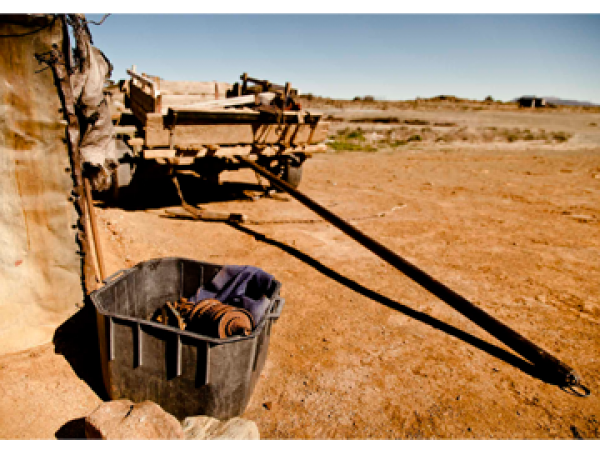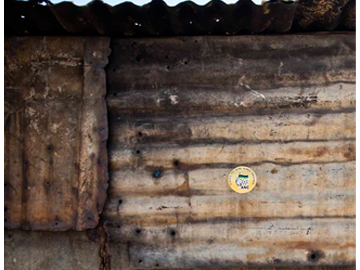The poorest of the poor: The Karretjie Mense of the Great Karoo

In and around Colesberg, a small historical town on the N1 mid-way between Cape Town and Johannesburg, I met a group of impoverished sheep shearers living in abject poverty, surviving in tiny tin shacks on the verges of public roads. Only recently, in the last 15 years, have they become a settled, sedentary people.
They are known as the Karretjie Mense of the Karoo, a label they have given themselves because for the last 80 years, prior to the recent shifts in agricultural and political landscapes, they lived nomadically on donkey carts.1
The Karretjie Mense developed skills that allowed them to move around. Because the greater Colesberg area is comprised of some half a million hectares of farming land, and a majority of that is Merino sheep farming, they took on the task of sheep shearing and fence-fixing. This allowed them to move about the landscape setting up camp at certain locations, doing their work, and moving on to the next area that needed their skills.
I’m 50 kilometers south-east of Colesberg, at a small outspan at a T-junction in the middle of no-where. There are three families living here. There is no running water and definitely no electricity. Dogs are tied down by chains, and live in small corrugated iron kennels. There aren’t any trees around; it’s winter, and firewood is high currency. Piet Bekkers is hitting at an old dry log with a ‘bos-pik’, hacking off small splinters for his fire tonight. The shack he lives in is full of holes, and once the sun has dropped, temperatures will fall below zero.
I chat to Liesbet Booysen, who has lived at this intersection for 15 years: “There are no jobs in Colesberg. We live out here so that we can get occasional ‘los-werk’ from farmers who live around here. My dad used to live here. He now lives on a farm. I grew up on the karretjie with him, but now that we don’t move, we must stay here and wait for work.”
Her husband comes out of their home, a small zinc shack with a faded yellow sticker stuck on it with the words: “This is an ANC home”. His name is Hendrik Hermanus. He explains further, “The days on the road were much better. The farmers let us shear, and there was always work. Now that the farmers use electric shearers, us karretjie shearers have no work.”

A faded yellow sticker reads “This is an ANC home”. Photo by Timothy Gabb.
Farmers have started using outsourced, unionized teams of shearers from Lesotho, who arrive in a team with electrified shears. Although it is still commonly agreed that the traditional hand shearers are better than the electrified ones, they are too slow for the modern pace of wool production. This has rendered the Karretjie Mense redundant, as they try to adapt to a rapidly changing political economy of the wool trade.
The Karretjie Mense are obviously not unionized and therefore have subservient and weak bargaining positions. They do not live on the farms and therefore farmers have minimal responsibility towards them. When they do get work, they are paid very little. Even when they are shearing, they are paid up to R3.50 per sheep. On average they shear 25 to 30 sheep per day and therefore earn about R87 to R105 per day. These amounts vary and depends upon the amount of sheep needing shearing and the seasonality of the job. The shearers typically get one sheep to slaughter per 1000 shorn. They otherwise receive no benefits and have to pay for everything they need to survive during the shearing period.

Farmers sometimes drop off rooikats with Hendrik after they have been trapped and shot. Photo by Timothy Gabb.
Hendrik shows me around the outspan. I see a box of pelts on his roof. I ask him what it is. “It’s a Rooikat.”
He walks around to the back of his shack and gestures for me to follow. He bends down into some long grass, and lifts up a slightly decayed head, with the skin still attached. It’s another, smaller, Rooikat, a bullet hole clearly seen in the centre of the creature’s skull.
“We eat it,” he explains. “Farmers drop it off for us after they’ve trapped and shot them, and we eat it.”
“What’s it taste like?” I ask.
“It tastes like chicken,” he answers. “The meat is white.”
It is commonly thought that the relationship between the farmer and the shearer is symbiotic, since a skill is exchanged for a wage; but rather, it seems quite obviously the opposite. The farmers only have to deal with the shearers when it suits them. They are able, due to the fact that the hand-shearers are not represented by any union and that they are wholly dependent upon the farmers for employment, to exploit this labour.
Since sheep shearing is seasonal work, the shearers are dependent on the times when they are needed by the farmer to provide for their families in the times when work is scarce. And now that hand-shearing is dwindling, the Karretjie Mense are forced into a corner where they sit and wait for something to happen. They lack dignity and recognition. Their future is uncertain. They have almost no visibility in the media or in policy discussions. They are unmistakably the poorest of the poor. They have been socio-politically sidelined, and have become strangers in their own land.
The author finished studying journalism at Rhodes University at the end of 2011. He has since started his own freelance company, gabflyMEDIA, which attempts to mediate the voice of the marginalized.
-
De Jongh, Michael. 2012. Roots and Routes: Karretjie People of the Great Karoo: The Marginalisation of a South African First People. UNISA Press: Pretoria. ↩
Support independent journalism
Donate using Payfast

Don't miss out on the latest news
We respect your privacy, and promise we won't spam you.

This article is licensed under a Creative Commons Attribution-NoDerivatives 4.0 International License.
